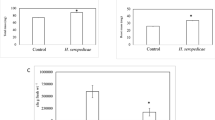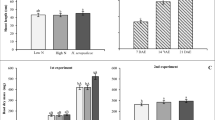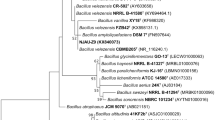Abstract
The plant growth promoting bacteria Herbaspirillum seropedicae is an important model to study biological nitrogen fixation and it is proposed as crop inoculants for grasses. In this study we developed new tools to evaluate the abundance of H. seropedicae SmR1 and its expression in planta and investigated the association of the plant growth promoting bacteria H. seropedicae with maize grown in sterile and nonsterile conditions. Maize seedlings (P30F53) were inoculated with H. seropedicae SmR1 and grown in vitro and in soil. The plants were sampled at 4, 7 and 10 (in vitro) or 14, 21 and 28 days after inoculation (soil). Using qPCR we quantified H. seropedicae DNA and measured nifH, rpoC and hrcN levels of bacterial transcripts. In vitro assay inoculated plants presented highest amount of DNA and transcript contents, not detected in control plants. nifH and rpoC gene expression were detected on roots of inoculated maize cultivated in both growth conditions. However, it was not possible to detect hrcN gene expression in maize roots cultivated in soil. TaqMan assay is species-specific for H. seropedicae DNA and nifH and rpoC transcript levels could be used to monitor H. seropedicae gene expression in planta in sterile and nonsterile growth conditions. We developed specific, reliable and efficient tools to monitor H. seropedicae DNA abundance and H. seropedicae nifH and rpoC expression in planta.



Similar content being viewed by others
References
Alves GC, Videira SS, Urquiaga S, Reis VM (2015) Differential plant growth promotion and nitrogen fixation in two genotypes of maize by several Herbaspirillum inoculants. Plant Soil 387(1–2):307–321. doi:10.1007/s11104-014-2295-2
Amaral FP, Pankievicz VCS, Arisi ACM, Souza EM, Pedrosa F, Stacey G (2016) Differential growth responses of Brachypodium distachyon genotypes to inoculation with plant growth promoting rhizobacteria. Plant Mol Biol 90(6):689–697. doi:10.1007/s11103-016-0449-8
Babalola OO (2010) Beneficial bacteria of agricultural importance. Biotechnol Lett 32(11):1559–1570. doi:10.1007/s10529-010-0347-0
Baldani JI, Baldani VLD, Seldin L, Dobereiner J (1986) Characterization of Herbaspirillum seropedicae Gen-Nov, Sp-Nov, a root-associated nitrogen-fixing bacterium. Int J Syst Bacteriol 36(1):86–93
Balsanelli E, Serrato RV, de Baura VA, Sassaki G, Yates MG, Rigo LU, Pedrosa FO, de Souza EM, Monteiro RA (2010) Herbaspirillum seropedicae rfbB and rfbC genes are required for maize colonization. Environ Microbiol 12(8):2233–2244. doi:10.1111/j.1462-2920.2010.02187.x
Balsanelli E, Tadra-Sfeir MZ, Faoro H, Pankievicz VCS, de Baura VA, Pedrosa FO, de Souza EM, Dixon R, Monteiro RA (2015) Molecular adaptations of Herbaspirillum seropedicae during colonization of the maize rhizosphere. Environ Microbiol. doi:10.1111/1462-2920.12887
Baudoin E, Couillerot O, Spaepen S, Moenne-Loccoz Y, Nazaret S (2010) Applicability of the 16S–23S rDNA internal spacer for PCR detection of the phytostimulatory PGPR inoculant Azospirillum lipoferum CRT1 in field soil. J Appl Microbiol 108(1):25–38. doi:10.1111/j.1365-2672.2009.04393.x
Berg G (2009) Plant–microbe interactions promoting plant growth and health: perspectives for controlled use of microorganisms in agriculture. Appl Microbiol Biotechnol 84(1):11–18. doi:10.1007/s00253-009-2092-7
Bhattacharjee RB, Singh A, Mukhopadhyay SN (2008) Use of nitrogen-fixing bacteria as biofertiliser for non-legumes: prospects and challenges. Appl Microbiol Biotechnol 80(2):199–209. doi:10.1007/s00253-008-1567-2
Brusamarello-Santos LCC, Pacheco F, Aljanabi SMM, Monteiro RA, Cruz LM, Baura VA, Pedrosa FO, Souza EM, Wassem R (2012) Differential gene expression of rice roots inoculated with the diazotroph Herbaspirillum seropedicae. Plant Soil 356(1–2):113–125. doi:10.1007/s11104-011-1044-z
Bustin S, Benes V, Garson J, Hellemans J, Huggett J, Kubista M, Mueller R, Nolan T, Pfaffl M, Shipley G, Vandesompele J, Wittwer C (2009) The MIQE guidelines: minimum information for publication of quantitative real-time PCR experiments. Clin Chem 55(4):611–622. doi:10.1373/clinchem.2008.112797
Carvalho TLG, Balsemao-Pires E, Saraiva RM, Ferreira PCG, Hemerly AS (2014) Nitrogen signalling in plant interactions with associative and endophytic diazotrophic bacteria. J Exp Bot 65(19):5631–5642. doi:10.1093/jxb/eru319
Chebotar VK, Malfanova NV, Shcherbakov AV, Ahtemova GA, Borisov AY, Lugtenberg B, Tikhonovich IA (2015) Endophytic bacteria in microbial preparations that improve plant development (review). Appl Biochem Microbiol 51(3):271–277. doi:10.1134/s0003683815030059
Chubatsu LS, Monteiro RA, de Souza EM, de Oliveira MAS, Yates MG, Wassem R, Bonatto AC, Huergo LF, Steffens MBR, Rigo LU, Pedrosa FD (2012) Nitrogen fixation control in Herbaspirillum seropedicae. Plant Soil 356(1–2):197–207. doi:10.1007/s11104-011-0819-6
Cordeiro FA, Tadra-Sfeir MZ, Huergo LF, Pedrosa FD, Monteiro RA, de Souza EM (2013) Proteomic analysis of Herbaspirillum seropedicae cultivated in the presence of sugar cane extract. J Proteome Res 12(3):1142–1150. doi:10.1021/pr300746j
Couillerot O, Bouffaud M-L, Baudoin E, Muller D, Caballero-Mellado J, Moenne-Loccoz Y (2010) Development of a real-time PCR method to quantify the PGPR strain Azospirillum lipoferum CRT1 on maize seedlings. Soil Biol Biochem 42(12):2298–2305. doi:10.1016/j.soilbio.2010.09.003
Couillerot O, Ramirez-Trujillo A, Walker V, von Felten A, Jansa J, Maurhofer M, Defago G, Prigent-Combaret C, Comte G, Caballero-Mellado J, Moenne-Loccoz Y (2013) Comparison of prominent Azospirillum strains in Azospirillum–Pseudomonas–Glomus consortia for promotion of maize growth. Appl Microbiol Biotechnol 97(10):4639–4649. doi:10.1007/s00253-012-4249-z
da Silva Lima L, Olivares F, de Rodrigues Oliveira R, Vega M, Aguiar N, Canellas L (2014) Root exudate profiling of maize seedlings inoculated with Herbaspirillum seropedicae and humic acids. Chem Biol Technol Agric C7–C231(1):1–18. doi:10.1186/s40538-014-0023-z
Desvaux M, Parham NJ, Scott-Tucker A, Henderson IR (2004) The general secretory pathway: a general misnomer? Trends Microbiol 12(7):306–309. doi:10.1016/j.tim.2004.05.002
Dixon R, Kahn D (2004) Genetic regulation of biological nitrogen fixation. Nat Rev Microbiol 2(8):621–631. doi:10.1038/nrmicro954
dos Reis FB Jr, Reis VM, Urquiaga S, Dobereiner J (2000) Influence of nitrogen fertilisation on the population of diazotrophic bacteria Herbaspirillum spp. and Acetobacter diazotrophicus in sugar cane (Saccharum spp.). Plant Soil 219(1–2):153–159
Elbeltagy A, Nishioka K, Sato T, Suzuki H, Ye B, Hamada T, Isawa T, Mitsui H, Minamisawa K (2001) Endophytic colonization and in planta nitrogen fixation by a Herbaspirillum sp. isolated from wild rice species. Appl Environ Microbiol 67(11):5285–5293. doi:10.1128/aem.67.11.5285-5293.2001
Faleiro AC, Pereira TP, Espindula E, Brod FCA, Arisi ACM (2013) Real time PCR detection targeting nifA gene of plant growth promoting bacteria Azospirillum brasilense strain FP2 in maize roots. Symbiosis 61(3):125–133. doi:10.1007/s13199-013-0262-y
Ferrari CS, Amaral FP, Ferreira Bueno JC, Scariot MC, Valentim-Neto PA, Maisonnave Arisi AC (2014) Expressed proteins of Herbaspirillum seropedicae in maize (DKB240) roots–bacteria interaction revealed using proteomics. Appl Biochem Biotechnol 174(6):2267–2277. doi:10.1007/s12010-014-1197-3
Galisa PS, da Silva HAP, Macedo AVM, Reis VM, Vidal MS, Baldani JI, Simoes-Araujo JL (2012) Identification and validation of reference genes to study the gene expression in Gluconacetobacter diazotrophicus grown in different carbon sources using RT-qPCR. J Microbiol Methods 91(1):1–7. doi:10.1016/j.mimet.2012.07.005
Germida JJ, Siciliano SD, de Freitas JR, Seib AM (1998) Diversity of root-associated bacteria associated with held-grown canola (Brassica napus L.) and wheat (Triticum aestivum L.). FEMS Microbiol Ecol 26(1):43–50. doi:10.1111/j.1574-6941.1998.tb01560.x
Gyaneshwar P, James EK, Reddy PM, Ladha JK (2002) Herbaspirillum colonization increases growth and nitrogen accumulation in aluminium-tolerant rice varieties. New Phytol 154(1):131–145. doi:10.1046/j.1469-8137.2002.00371.x
Hardoim PR, van Overbeek LS, Berg G, Pirttilä AM, Compant S, Campisano A, Döring M, Sessitsch A (2015) The hidden world within plants: ecological and evolutionary considerations for defining functioning of microbial endophytes. Microbiol Mol Biol Rev 79(3):293–320. doi:10.1128/MMBR.00050-14
He SY, Nomura K, Whittam TS (2004) Type III protein secretion mechanism in mammalian and plant pathogens. Biochim Biophys Acta 1694(1–3):181–206. doi:10.1016/j.bbamcr.2004.03.011
Heid CA, Stevens J, Livak KJ, Williams PM (1996) Real time quantitative PCR. Genome Res 6(10):986–994. doi:10.1101/gr.6.10.986
James EK, Olivares FL, Baldani JI, Dobereiner J (1997) Herbaspirillum, an endophytic diazotroph colonizing vascular tissue in leaves of Sorghum bicolor L. Moench. J Exp Bot 48(308):785–797. doi:10.1093/jxb/48.3.785
James EK, Gyaneshwar P, Mathan N, Barraquio QL, Reddy PM, Iannetta PPM, Olivares FL, Ladha JK (2002) Infection and colonization of rice seedlings by the plant growth-promoting bacterium Herbaspirillum seropedicae Z67. Mol Plant Microbe Interact 15(9):894–906. doi:10.1094/mpmi.2002.15.9.894
Kim SE, Moon JS, Choi WS, Lee EN, Lee SH, Kim SU (2010) Qualitative and quantitative detection of agricultural microorganisms expressing iturin and mop cyclase in soils. J Agric Food Chem 58(24):12657–12663. doi:10.1021/jf103216g
Klassen G, Pedrosa FO, Souza EM, Funayama S, Rigo LU (1997) Effect of nitrogen compounds on nitrogenase activity in Herbaspirillum seropedicae SMR1. Can J Microbiol 43(9):887–891
Kutyavin IV, Afonina IA, Mills A, Gorn VV, Lukhtanov EA, Belousov ES, Singer MJ, Walburger DK, Lokhov SG, Gall AA, Dempcy R, Reed MW, Meyer RB, Hedgpeth J (2000) 3′-minor groove binder-DNA probes increase sequence specificity at PCR extension temperatures. Nucleic Acids Res 28(2):655–661. doi:10.1093/nar/28.2.655
Li W, Teixeira DC, Hartung JS, Huang Q, Duan Y, Zhou L, Chen J, Lin H, Lopes S, Juliano Ayres A, Levy L (2013) Development and systematic validation of qPCR assays for rapid and reliable differentiation of Xylella fastidiosa strains causing citrus variegated chlorosis. J Microbiol Methods 92(1):79–89. doi:10.1016/j.mimet.2012.10.008
Liu XM, Zhao HX, Chen SF (2006) Colonization of maize and rice plants by strain Bacillus megaterium C4. Curr Microbiol 52(3):186–190. doi:10.1007/s00284-005-0162-3
Machado IMP, Yates MG, Machado HB, Souza EM, Pedrosa FO (1996) Cloning and sequencing of the nitrogenase structural genes nifHDK of Herbaspirillum seropedicae. Braz J Med Biol Res 29(12):1599–1602
Martensson L, Diez B, Wartiainen I, Zheng WW, El-Shehawy R, Rasmussen U (2009) Diazotrophic diversity, nifH gene expression and nitrogenase activity in a rice paddy field in Fujian, China. Plant Soil 325(1–2):207–218. doi:10.1007/s11104-009-9970-8
Martin-Sanchez PM, Bastian F, Alabouvette C, Saiz-Jimenez C (2013) Real-time PCR detection of Ochroconis lascauxensis involved in the formation of black stains in the Lascaux Cave, France. Sci Total Environ 443:478–484. doi:10.1016/j.scitotenv.2012.11.026
Monteiro RA, Schmidt MA, de Baura VA, Balsanelli E, Wassem R, Yates MG, Randi MAF, Pedrosa FO, de Souza EM (2008) Early colonization pattern of maize (Zea mays L. Poales, Poaceae) roots by Herbaspirillum seropedicae (Burkholderiales, Oxalobacteraceae). Genet Mol Biol 31(4):932–937. doi:10.1590/s1415-47572008005000007
Monteiro RA, Balsanelli E, Wassem R, Marin AM, Brusamarello-Santos LCC, Schmidt MA, Tadra-Sfeir MZ, Pankievicz VCS, Cruz LM, Chubatsu LS, Pedrosa FO, Souza EM (2012) Herbaspirillum–plant interactions: microscopical, histological and molecular aspects. Plant Soil 356(1–2):175–196. doi:10.1007/s11104-012-1125-7
Olivares FL, Baldani VLD, Reis VM, Baldani JI, Dobereiner J (1996) Occurrence of the endophytic diazotrophs Herbaspirillum spp. in roots, stems, and leaves, predominantly of Gramineae. Biol Fertil Soils 21(3):197–200
Olivares FL, James EK, Baldani JI, Dobereiner J (1997) Infection of mottled stripe disease-susceptible and resistant sugar cane varieties by the endophytic diazotroph Herbaspirillum. New Phytol 135(4):723–737. doi:10.1046/j.1469-8137.1997.00684.x
Oliveira AC, Vallim MA, Semighini CP, Araujo WL, Goldman GH, Machado MA (2002) Quantification of Xylella fastidiosa from citrus trees by real-time polymerase chain reaction assay. Phytopathology 92(10):1048–1054. doi:10.1094/phyto.2002.92.10.1048
Pankievicz VCS, do Amaral FP, Santos K, Agtuca B, Xu YW, Schueller MJ, Arisi ACM, Steffens MBR, de Souza EM, Pedrosa FO, Stacey G, Ferrieri RA (2015) Robust biological nitrogen fixation in a model grass-bacterial association. Plant J 81(6):907–919. doi:10.1111/tpj.12777
Pariona-Llanos R, Ferrara FID, Gonzales HHS, Barbosa HR (2010) Influence of organic fertilization on the number of culturable diazotrophic endophytic bacteria isolated from sugarcane. Eur J Soil Biol 46(6):387–393. doi:10.1016/j.ejsobi.2010.08.003
Pedrosa FO, Monteiro RA, Wassem R, Cruz LM, Ayub RA, Colauto NB, Fernandez MA, Fungaro MHP, Grisard EC, Hungria M, Madeira HMF, Nodari RO, Osaku CA, Petzl-Erler ML, Terenzi H, Vieira LGE, Steffens MBR, Weiss VA, Pereira LFP, Almeida MIM, Alves LR, Marin A, Araujo LM, Balsanelli E, Baura VA, Chubatsu LS, Faoro H, Favetti A, Friedermann G, Glienke C, Karp S, Kava-Cordeiro V, Raittz RT, Ramos HJO, Ribeiro E, Rigo LU, Rocha SN, Schwab S, Silva AG, Souza EM, Tadra-Sfeir MZ, Torres RA, Dabul ANG, Soares MAM, Gasques LS, Gimenes CCT, Valle JS, Ciferri RR, Correa LC, Murace NK, Pamphile JA, Patussi EV, Prioli AJ, Prioli SMA, Rocha C, Arantes OMN, Furlaneto MC, Godoy LP, Oliveira CEC, Satori D, Vilas-Boas LA, Watanabe MAE, Dambros BP, Guerra MP, Mathioni SM, Santos KL, Steindel M, Vernal J, Barcellos FG, Campo RJ, Chueire LMO, Nicolas MF, Pereira-Ferrari L, Silva JLD, Gioppo NMR, Margarido VP, Menck-Soares MA, Pinto FGS, Simao RDG, Takahashi EK, Yates MG (2011) Genome of Herbaspirillum seropedicae Strain SmR1, a specialized diazotrophic endophyte of tropical grasses. Plos Genetics 7(5):10. doi:10.1371/journal.pgen.1002064
Pereira TP, do Amaral FP, Dall’Asta P, Angonesi Brod FC, Maisonnave Arisi AC (2014) Real-time PCR quantification of the plant growth promoting bacteria Herbaspirillum seropedicae strain SmR1 in maize roots. Mol Biotechnol 56(7):660–670. doi:10.1007/s12033-014-9742-4
Peters JW, Fisher K, Dean DR (1995) Nitrogenase structure and function: a biochemical-genetic perspective. Annu Rev Microbiol 49:335–366
Price EP, Dale JL, Cook JM, Sarovich DS, Seymour ML, Ginther JL, Kaufman EL, Beckstrom-Sternberg SM, Mayo M, Kaestli M, Glass MB, Gee JE, Wuthiekanun V, Warner JM, Baker A, Foster JT, Tan P, Tuanyok A, Limmathurotsakul D, Peacock SJ, Currie BJ, Wagner DM, Keim P, Pearson T (2012) Development and validation of Burkholderia pseudomallei-specific real-time PCR assays for clinical, environmental or forensic detection applications. PLoS ONE 7(5):9. doi:10.1371/journal.pone.0037723
Rees DC, Howard JB (2000) Nitrogenase: standing at the crossroads. Curr Opin Chem Biol 4(5):559–566. doi:10.1016/s1367-5931(00)00132-0
Rodriguez-Blanco A, Sicardi M, Frioni L (2015) Plant genotype and nitrogen fertilization effects on abundance and diversity of diazotrophic bacteria associated with maize (Zea mays L.). Biol Fertil Soils 51(3):391–402. doi:10.1007/s00374-014-0986-8
Rodriguez-Salazar J, Suarez R, Caballero-Mellado J, Iturriaga G (2009) Trehalose accumulation in Azospirillum brasilense improves drought tolerance and biomass in maize plants. FEMS Microbiol Lett 296(1):52–59. doi:10.1111/j.1574-6968.2009.01614.x
Roncato-Maccari LDB, Ramos HJO, Pedrosa FO, Alquini Y, Chubatsu LS, Yates MG, Rigo LU, Steffens MBR, Souza EM (2003) Endophytic Herbaspirillum seropedicae expresses nif genes in gramineous plants. FEMS Microbiol Ecol 45(1):39–47. doi:10.1016/s0168-6496(03)00108-9
Rosenblueth M, Martinez-Romero E (2006) Bacterial endophytes and their interactions with hosts. Mol Plant Microbe Interact 19(8):827–837. doi:10.1094/mpmi-19-0827
Shime-Hattori A, Kobayashi S, Ikeda S, Asano R, Shime H, Shinano T (2011) A rapid and simple PCR method for identifying isolates of the genus Azospirillum within populations of rhizosphere bacteria. J Appl Microbiol 111(4):915–924. doi:10.1111/j.1365-2672.2011.05115.x
Stets MI, Pinto AS, Huergo LF, de Souza EM, Guimaraes VF, Alves AC, Steffens MBR, Monteiro RA, Pedrosa FD, Cruz LM (2013) Rapid identification of bacterial isolates from wheat roots by high resolution whole cell MALDI-TOF MS analysis. J Biotechnol 165(3–4):167–174. doi:10.1016/j.jbiotec.2013.04.001
Stets MI, Alqueres SMC, Souza EM, Pedrosa FD, Schmid M, Hartmann A, Cruz LM (2015) Quantification of Azospirillum brasilense FP2 bacteria in wheat roots by strain-specific quantitative PCR. Appl Environ Microbiol 81(19):6700–6709. doi:10.1128/aem.01351-15
Su’udi M, Kim J, Park JM, Bae SC, Kim D, Kim YH, Ahn IP (2013) Quantification of rice blast disease progressions through Taqman real-time PCR. Mol Biotechnol 55(1):43–48. doi:10.1007/s12033-012-9632-6
Tadra-Sfeir MZ, Faoro H, Camilios-Neto D, Brusamarello-Santos L, Balsanelli E, Weiss V, Baura VA, Wassem R, Cruz LM, Pedrosa FD, Souza EM, Monteiro RA (2015) Genome wide transcriptional profiling of Herbaspirillum seropedicae SmR1 grown in the presence of naringenin. Front Microbiol 6:8. doi:10.3389/fmicb.2015.00491
Timmusk S, Paalme V, Lagercrantz U, Nevo E (2009) Detection and quantification of Paenibacillus polymyxa in the rhizosphere of wild barley (Hordeum spontaneum) with real-time PCR. J Appl Microbiol 107(3):736–745. doi:10.1111/j.1365-2672.2009.04265.x
Tseng TT, Tyler BM, Setubal JC (2009) Protein secretion systems in bacterial-host associations, and their description in the gene ontology. BMC Microbiol 9:9. doi:10.1186/1471-2180-9-s1-s2
Vargas L, Gurjao de Carvalho TL, Gomes Ferreira PC, Divan Baldani VL, Baldani JI, Hemerly AS (2012) Early responses of rice (Oryza sativa L.) seedlings to inoculation with beneficial diazotrophic bacteria are dependent on plant and bacterial genotypes. Plant Soil 356(1–2):127–137. doi:10.1007/s11104-012-1274-8
Vargas L, Brigida ABS, Mota JP, de Carvalho TG, Rojas CA, Vaneechoutte D, Van Bel M, Farrinelli L, Ferreira PCG, Vandepoele K, Hemerly AS (2014) Drought tolerance conferred to sugarcane by association with Gluconacetobacter diazotrophicus: a transcriptomic view of hormone pathways. PLoS ONE 9(12):37. doi:10.1371/journal.pone.0114744
Zhang T, Fang HHP (2006) Applications of real-time polymerase chain reaction for quantification of microorganisms in environmental samples. Appl Microbiol Biotechnol 70(3):281–289. doi:10.1007/s00253-006-0333-6
Acknowledgements
This work was financially supported by the National Institute of Science and Technology-Biological Nitrogen Fixation (INCT-FBN), National Counsel of Technological and Scientific Development (CNPq), Ministry of Science and Technology, Brazil. Pâmela Dall Asta, Tomás Pellizzaro Pereira and Fernanda Plucani Amaral were recipients of PhD fellowships from Coordination of Personnel Improvement of Higher Education (CAPES), Ministry of Education, Brazil and Ana Carolina Maisonnave Arisi is recipient of research fellowship (PQ2) from CNPq.
Author information
Authors and Affiliations
Corresponding author
Ethics declarations
Conflict of interest
No conflict of interest declared.
Electronic supplementary material
Below is the link to the electronic supplementary material.
Rights and permissions
About this article
Cite this article
Dall’Asta, P., Pereira, T.P., do Amaral, F.P. et al. Tools to evaluate Herbaspirillum seropedicae abundance and nifH and rpoC expression in inoculated maize seedlings grown in vitro and in soil. Plant Growth Regul 83, 397–408 (2017). https://doi.org/10.1007/s10725-017-0306-z
Received:
Accepted:
Published:
Issue Date:
DOI: https://doi.org/10.1007/s10725-017-0306-z




